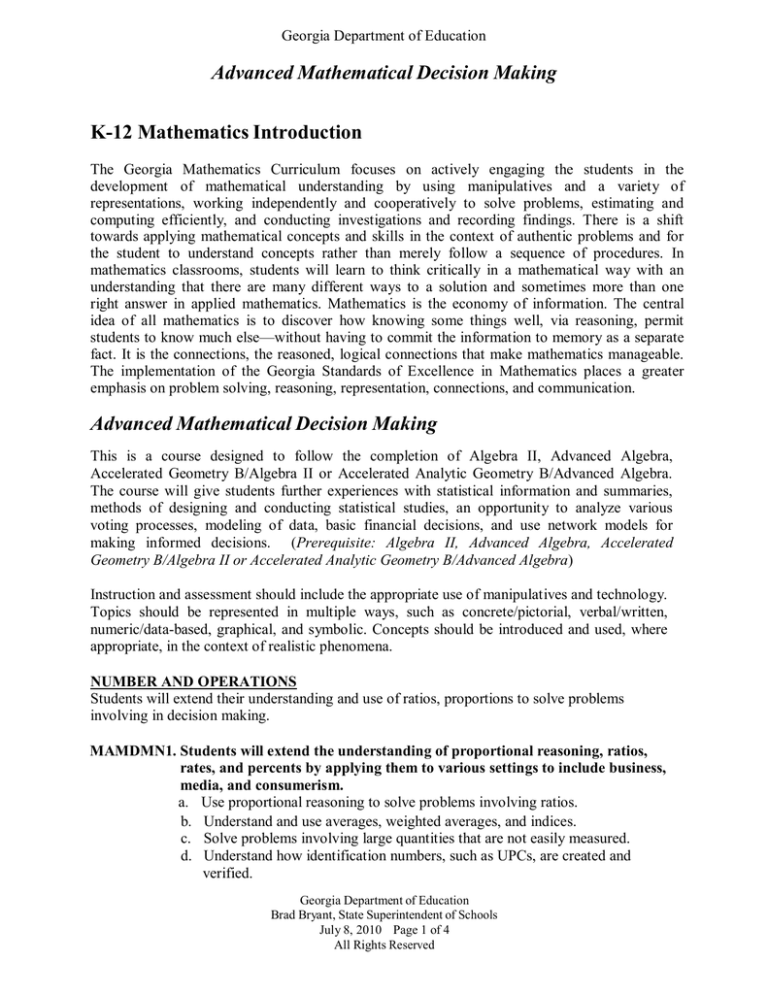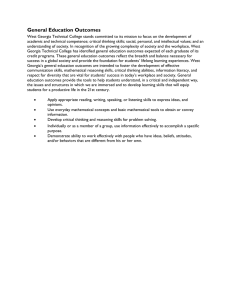
Georgia Department of Education
Advanced Mathematical Decision Making
K-12 Mathematics Introduction
The Georgia Mathematics Curriculum focuses on actively engaging the students in the
development of mathematical understanding by using manipulatives and a variety of
representations, working independently and cooperatively to solve problems, estimating and
computing efficiently, and conducting investigations and recording findings. There is a shift
towards applying mathematical concepts and skills in the context of authentic problems and for
the student to understand concepts rather than merely follow a sequence of procedures. In
mathematics classrooms, students will learn to think critically in a mathematical way with an
understanding that there are many different ways to a solution and sometimes more than one
right answer in applied mathematics. Mathematics is the economy of information. The central
idea of all mathematics is to discover how knowing some things well, via reasoning, permit
students to know much else—without having to commit the information to memory as a separate
fact. It is the connections, the reasoned, logical connections that make mathematics manageable.
The implementation of the Georgia Standards of Excellence in Mathematics places a greater
emphasis on problem solving, reasoning, representation, connections, and communication.
Advanced Mathematical Decision Making
This is a course designed to follow the completion of Algebra II, Advanced Algebra,
Accelerated Geometry B/Algebra II or Accelerated Analytic Geometry B/Advanced Algebra.
The course will give students further experiences with statistical information and summaries,
methods of designing and conducting statistical studies, an opportunity to analyze various
voting processes, modeling of data, basic financial decisions, and use network models for
making informed decisions. (Prerequisite: Algebra II, Advanced Algebra, Accelerated
Geometry B/Algebra II or Accelerated Analytic Geometry B/Advanced Algebra)
Instruction and assessment should include the appropriate use of manipulatives and technology.
Topics should be represented in multiple ways, such as concrete/pictorial, verbal/written,
numeric/data-based, graphical, and symbolic. Concepts should be introduced and used, where
appropriate, in the context of realistic phenomena.
NUMBER AND OPERATIONS
Students will extend their understanding and use of ratios, proportions to solve problems
involving in decision making.
MAMDMN1. Students will extend the understanding of proportional reasoning, ratios,
rates, and percents by applying them to various settings to include business,
media, and consumerism.
a. Use proportional reasoning to solve problems involving ratios.
b. Understand and use averages, weighted averages, and indices.
c. Solve problems involving large quantities that are not easily measured.
d. Understand how identification numbers, such as UPCs, are created and
verified.
Georgia Department of Education
Brad Bryant, State Superintendent of Schools
July 8, 2010 Page 1 of 4
All Rights Reserved
Georgia Department of Education
Advanced Mathematical Decision Making
ALGEBRA
Students will explore the applications of functions, their characteristics and their use in modeling.
Vectors and matrices are employed for solving problems.
MAMDMA1. Students will use vectors and matrices to organize and describe problem
situations.
a. Represent situations and solve problems using vectors in areas such as
transportation, computer graphics, and the physics of force and motion.
b. Represent geometric transformations and solve problems using matrices in
fields such as computer animations.
MAMDMA2. Students will use a variety of network models to organize data in
quantitative situations, make informed decisions, and solve problems.
a. Solve problems represented by a vertex-edge graph, and find critical paths,
Euler paths, and minimal spanning trees.
b. Construct, analyze, and interpret flow charts to develop an algorithm to
describe processes such as quality control procedures.
c. Investigate the scheduling of projects using PERT.
d. Consider problems that can be resolved by coloring graphs.
MAMDMA3. Students will create and analyze mathematical models to make decisions
related to earning, investing, spending, and borrowing money.
a. Use exponential functions to model change in a variety of financial situations.
b. Determine, represent, and analyze mathematical models for income,
expenditures, and various types of loans and investments.
MAMDMA4. Students will analyze and evaluate the mathematics behind various methods
of voting and selection.
a. Evaluate various voting and selection processes to determine an appropriate
method for a given situation.
b. Apply various ranking algorithms to determine an appropriate method for a
given situation.
GEOMETRY
Students apply tools to model geometric situations and solve problems. Students extend their
knowledge of right triangle trigonometry.
MAMDMG1. Students will create and use two- and three-dimensional
representations of authentic situations.
MAMDMG2. Students will solve geometric problems involving inaccessible distances using
basic trigonometric principles, including the Law of Sines and the Law of
Cosines.
Georgia Department of Education
Brad Bryant, State Superintendent of Schools
July 8, 2010 Page 2 of 4
All Rights Reserved
Georgia Department of Education
Advanced Mathematical Decision Making
DATA ANAYLSIS AND PROBABILITY
Students will explore representations of data and models of data as tools in the decision making.
MAMDMD1. Students will determine probability and expected value to inform
everyday decision making.
a. Determine conditional probabilities and probabilities of compound events to
make decisions in problem situations.
b. Use probabilities to make and justify decisions about risks in everyday life.
c. Calculate expected value to analyze mathematical fairness, payoff,
and risk.
MAMDMD2. Students will build the skills and vocabulary necessary to analyze and
critique reported statistical information, summaries, and graphical
displays.
MAMDMD3. Students will apply statistical methods to design, conduct, and
analyze statistical studies.
MAMDMD4. Students will use functions to model problem situations in
both discrete and continuous relationships.
a. Determine whether a problem situation involving two quantities is best
modeled by a discrete (pattern identification, population growth, compound
interest) or continuous (medication dosage, climate change, bone decay)
relationship.
b. Use linear, exponential, logistic, piecewise and sine functions to
construct a model.
Terms/Symbols: Networks, weighted average, indices, vector, critical path, Euler path,
minimal spanning trees, PERT, Law of Sines, Law of Cosines, payoff, risk, discrete,
continuous, logistics, annuity, future value, present value, ranking, margin of error, cyclical,
period, amplitude, phase shift, commission, salary, perpetuity, electoral college, periodic
functions, statistical bias.
Process Standards
The following process standards are essential to mastering each of the mathematics content
standards. They emphasize critical dimensions of the mathematical proficiency that all students
need.
MM1P1. Students will solve problems (using appropriate technology).
a. Build new mathematical knowledge through problem solving.
b. Solve problems that arise in mathematics and in other contexts.
c. Apply and adapt a variety of appropriate strategies to solve problems.
d. Monitor and reflect on the process of mathematical problem solving.
Georgia Department of Education
Brad Bryant, State Superintendent of Schools
July 8, 2010 Page 3 of 4
All Rights Reserved
Georgia Department of Education
Advanced Mathematical Decision Making
MM1P2. Students will reason and evaluate mathematical arguments.
a. Recognize reasoning and proof as fundamental aspects of mathematics.
b. Make and investigate mathematical conjecture.
c. Develop and evaluate mathematical arguments and proofs.
d. Select and use various types of reasoning and methods of proof.
MM1P3. Students will communicate mathematically.
a. Organize and consolidate their mathematical thinking through communication.
b. Communicate their mathematical thinking coherently and clearly to peers, teachers, and
others.
c. Analyze and evaluate the mathematical thinking and strategies of others.
d. Use the language of mathematics to express mathematical ideas precisely.
MM1P4. Students will make connections among mathematical ideas and to other
disciplines.
a. Recognize and use connections among mathematical ideas.
b. Understand how mathematical ideas interconnect and build on one another to produce a
coherent whole.
c. Recognize and apply mathematics in contexts outside of mathematics.
MM1P5. Students will represent mathematics in multiple ways.
a. Create and use representations to organize, record, and communicate mathematical ideas.
b. Select, apply, and translate among mathematical representations to solve problems.
c. Use representations to model and interpret physical, social, and mathematical phenomena.
Georgia Department of Education
Brad Bryant, State Superintendent of Schools
July 8, 2010 Page 4 of 4
All Rights Reserved




